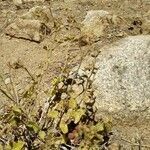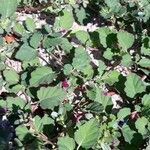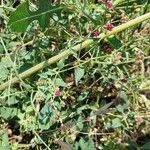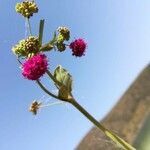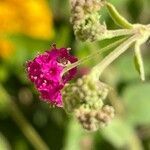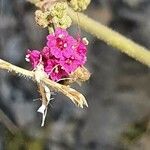Stems decumbent or prostrate, glabrate to densely pubescent, often with long septate hairs. Leaves with petioles (3-)5-15 (-25) mm long; lamina elliptic, oblong, ovate, lanceolate or oval, (11-)13-40 (-42) x (9-)10-30 (-33) mm; apex acute, apiculate or rounded; base shortly attenuate or rounded; margins entire; glabrous to puberulous, often with long septate hairs along veins and margins. Inflorescence with primary peduncles 54-118 mm long, secondary peduncles 32-43 mm long; 3-many flowers per cluster; pedicels 1 mm long. Flowers 1-4 mm long; lower part of perianth 1-1.5 mm long, ellipsoid, 5-ribbed, glandular hairs present; upper part of perianth 1-3 mm long, pink, purple or white. Stamens 1-5, 1.5-4.5 mm long. Ovary 0.4-0.6 mm long; style 1.3-4.0 mm. Anthocarp 3-5 x 1-2 mm, narrowly ellipsoid-clavate, 5-ribbed, with glandular hairs between ribs, ribs themselves glabrous or covered with hairs. Two forms of B. coccinea occur in southern Africa, the typical crimson-flowered neotropical taxon and a pink-or cream-flowered taxon with larger fruit.
Annual or perennial, prostrate, ascending or erect herb up to 1 m., sometimes with a thick taproot.. Stems fleshy, woody towards the base, sparsely pubescent to densely covered with long septate hairs, the nodes swollen.. Leaves broadly ovate to lanceolate, up to 5.5×5.5 cm., green above, pale green to greyish white beneath, sometimes tinged purple or spotted red, often pubescent on both surfaces and sometimes with long septate hairs, the base truncate to cuneate, the apex rounded to acute.. Inflorescences both axillary and terminal, simple and aggregated, (3–)5–7(–14)-flowered cymes; branches densely pubescent to sparingly minutely puberulous, never glabrous; axillary peduncles (1–)1.5–4.5 cm. long.. Perianth 1.5–3.5 mm. long; upper portion pale pink to purple, rarely white, 1–1.5 mm. long.. Stamens 2–3, slightly exserted.. Ovary ± 0.5 mm.; style slightly exserted.. Anthocarp obovoid to ellipsoid, 3–4×1–1.5 mm., 5-ribbed, glandular-pubescent.. Fig. 1/6.
Annual or perennial herb, 0.3-2.0 m long, sometimes viscid. Stems sprawling or ascending with erect flowering stems, diffusely branched, sparsely to densely glandular-pubescent, with interspersed long, septate hairs. Leaves 11-42 mm long, elliptic, oblong, ovate, lanceolate, oval, base shortly attenuate or rounded, apex acute, apiculate or rounded, glandular-pubescent along veins; petioles 3-35 mm long, glandular-pubescent.Inflorescences terminal and axillary, compound cymes; peduncles often stout; bracteoles 0.6-2.0 mm long, ovate, acuminate, margins fimbriate. Flowers 3-many per cluster. Perianth 1-4 mm long, campanulate, lower part green, coriaceous, elliptic, 5-ribbed, upper part petaloid, white or pink. Stamens Sub-Equal, exserted, 1.5-4.5 mm long. Ovary 0.4-0.6 mm long, glabrous; style long, exserted. Flowering time Sept.-Apr. Fruit 3-5 mm long anthocarp, 5-ribbed.
Annual or perennial herb, sprawling or ascending, 10–80 cm high, usually densely glandular-hairy; hairs a mixture of type 1 and type 2, the latter usually predominant or rarely absent. Leaves ovate or oblong, obtuse or shortly acute; lamina 0.5–6 cm long; petiole to 2.5 cm long. Inflorescences terminal and lateral, often compound; basic inflorescence unit a glomerule of 3–10 flowers; peduncle rigid, stout, to 3 cm long. Perianth glandular-hairy, the upper part campanulate, c. 2 mm long. Stamens usually 3, c. 1.5 mm long. Style 3 mm long, exserted. Fruit fusiform or narrowly clavate, c. 4 mm long, 1.5 mm wide, mucous; ribs 5, obtuse, glandular-hairy; furrows narrow.
Herbs annual or perennial. Stems sprawling to ascending, most parts glandular-pubescent, sometimes conspicuously so, occasionally apparently eglandular. Petiole well defined, to 3 cm; leaf blade very variable, lanceolate to suborbicular, to 1.8-6 × 1-5.5 cm, base cuneate to shallowly cordate, margin obscurely sinuate, apex rounded to acute. Inflorescences mostly terminal and subterminal, upper leaves reduced to form ascending panicle, 2-8-flowered clusters. Pedicel to 1 mm. Perianth limb white, pink, or mauve, rarely purplish red, to 2(-2.5) mm. Stamens (1-)3(-4), 1.5-4.5 mm. Anthocarp fusiform, 3-3.5(-4) mm, obviously 5-ribbed, usually glandular hairy.
Leaves 0.7–5.5 × 0.4–5 cm., ovate, elliptic or subcircular, base subcordate to rounded, apex rounded to acute, often apiculate or mucronate, glandular-pubescent mainly along the veins or more commonly more or less glabrous except for long, septate hairs particularly along veins and margins; petioles up to 4 cm. long, glandular-pubescent.
A herb. It can lie along the ground and be spreading. It can grow for one year or keep growing from year to year. It grows 0.1-1 m high. It can spread 2 m wide. The leaves are opposite and broadly triangle shaped. They are pale green. The flowers are pink. They are on long stalks.
Inflorescences terminal and axillary, cymose, often aggregated, repeated branching distally and reduction of superior leaves sometimes giving a paniculate appearance, glandular-pubescent, more rarely glabrescent, often viscid; peduncles often stout.
Anthocarps 3–4 × 0.8–1 mm., narrowly fusiform to clavate-fusiform, apex obtuse, glandular-pubescent, rarely glabrescent, ribs 5, smooth, rounded, glandular-pubescent, more rarely glabrescent.
Stems sprawling or ascending to 2–3 (4) m. with erect flowering stems, diffusely branched, sparsely to densely glandular-pubescent, often with interspersed long, septate hairs.
Perianth 1.75–3.5 mm. long, glandular-pubescent, lower portion 5-ribbed, upper portion 0.5–2.5 mm. long, campanulate, white, pink, magenta or mauve.
The W. African specimens differ from typical coccinea in the close pubescence of the stems and the pink (not crimson) flowers.
Stamens (1) 2–3 (4), subequal, exserted 1.5–4.5 mm. long, subequal, exserted.
Flowers 3-many per cluster, subsessile or with pedicels up to 1 mm. long.
Ovary 0.4–0.6 mm. long, glabrous; style 1.3–4.0 mm. long, exserted.
Bracteoles 0.6–2 mm. long, ovate, acuminate, margin fimbriate.
Annual or perennial herbs, sometimes viscid.
